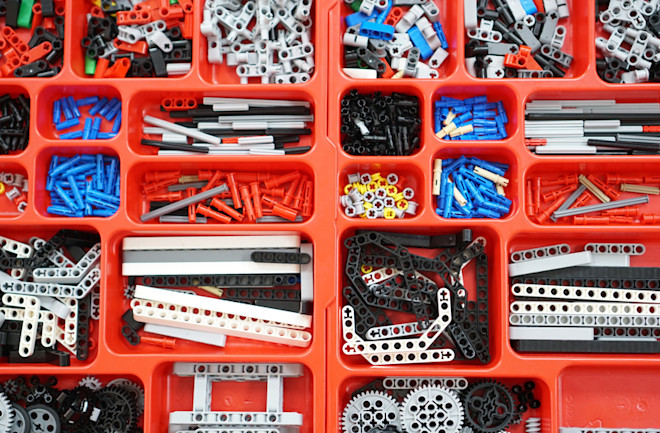Back in 1977, the Danish toy company, Lego, introduced a new set of interconnecting parts that allowed more complex constructions. This approach abandoned the iconic studded brick in favor of beams and connectors that create a vastly greater “space” of possible designs.
This studless product line is today called Lego Technic. It has evolved in various ways to include gears and motors and has even spawned several other Lego products such as Lego Bionicles and the modular robot system called Lego Mindstorm.
Lego Technic sets come with detailed instructions for how to assemble them into a motorized excavator or tractor or even a Lamborghini Sian Supercar.
But there is a problem. The huge flexibility of the studless approach makes it much harder to design with. Given a box of Lego Technic parts but no instructions, it’s tricky to come up with a design for a plane or a pistol or a bridge. And that leaves potential model-makers scratching their heads rather than expressing their creativity.
Computational Design
Enter Hao Xu at The Chinese University of Hong Kong and colleagues who have developed a way to turn a simple sketch into a Lego Technic design complete with detailed assembly instructions. They say their computational approach takes seconds compared to the many minutes or hours a professional Lego Technic model maker might spend on a similar project.
First some background. Traditional Lego bricks connect together using a single mechanism — the interconnecting studs on each brick. By contrast, Lego Technic parts connect together via various types of pins and connectors that fit into holes on beams and other parts. Some connectors act as axles and others allow joint rotation.
Due to the connection mechanisms using pins and connectors, Technic models have an entirely different and far more complex building style compared with the simple bottom-up style of regular Lego brick assemblies,” say Xu and co.
This immediately increases the “space” of possible designs. “For instance, there are over six billion ways of assembling a simple square with nine-unit long sides,” say Xu and co.
So the task Xu and co have to tackle is to search this huge space for a construction that reflects the design of an input sketch.
Their approach is eminently logical. They begin by characterizing the properties of all the parts and connectors, the connecting mechanisms and the rigidity of these connections they make. These properties are the basis of a vast space of all possible constructions.
Next, the team analyze an input sketch by estimating the orientation of all the beams needed to construct it and then working out how they must be connected. This is merely an objective design. The hard part is to find this design, or something similar, in the space of all possible Lego Technic designs. And having found a suitable construction, it has to be refined so that it uses a reasonably small number of parts.
That requires some hard computational grafting. The team begin by searching through the construction space for designs that approximately match the beam orientations. After that, they iteratively improve the design, based on the properties of the available connectors and pins and the goal of using as few different parts as possible.
At each stage, the computer compares this virtual model against the objective design to determine the progress. Any improvements are kept while any steps that reduce the similarity are abandoned. In this way, the virtual model inches towards a workable design.
At the end of the process, the computer spits out a design along with a set of assembly instructions.
Superhuman Ability
The initial results are impressive. Xu and co compared their computational approach to the way professional model-makers come up with designs. For example, given a sketch of an airplane, the computational approach produced a design in just 36 seconds compared with 1 hour and 23 minutes for a professional model-maker.
This pattern is played out over a wide variety of input sketches — a seesaw, Ferris wheel, bridge and even the International Space Station. In each case the computational approach is lightning quick and generally uses fewer parts than a professional model-maker.
There is more work to do, of course. Xu and co’s computational approach calculates the local rigidity of each connection but does not calculate the global rigidity of the whole construction. This can lead to some “floppy” models. Neither does the computational approach consider gears, pulleys and cables, which could dramatically increase the utility of the designs.
But these challenges are on the team’s to do list. In the meantime, Xu and co’s approach could breathe new life into the many boxes of Lego Technic parts — the broken remnants of models past — that are hidden beneath the nation’s beds.
Ref: Xu et al. 2020 Computational LEGO® Technic Design arxiv.org/abs/2007.02245. Published Nov 2019, ACM Trans. Graph. 38(6):196.




